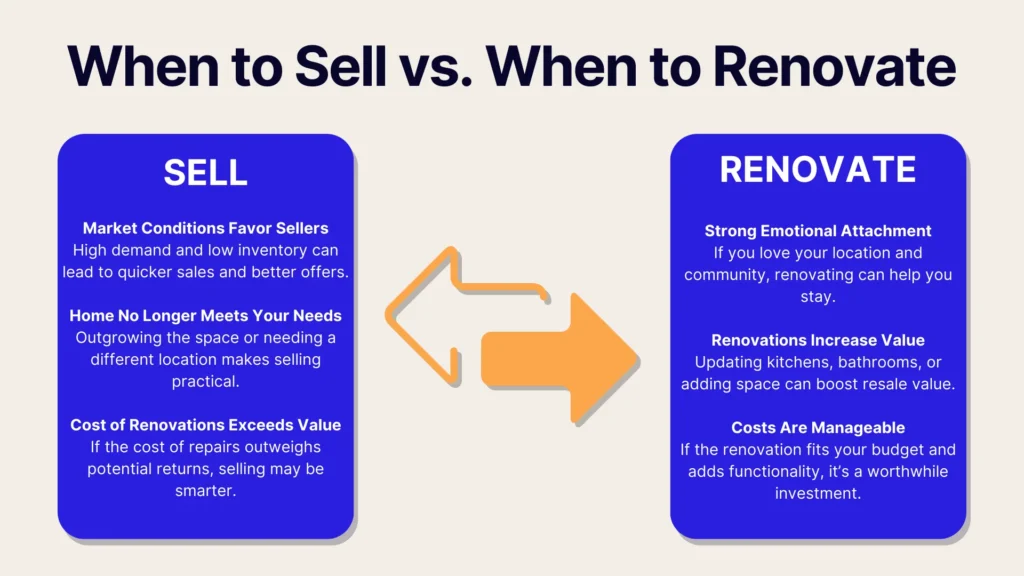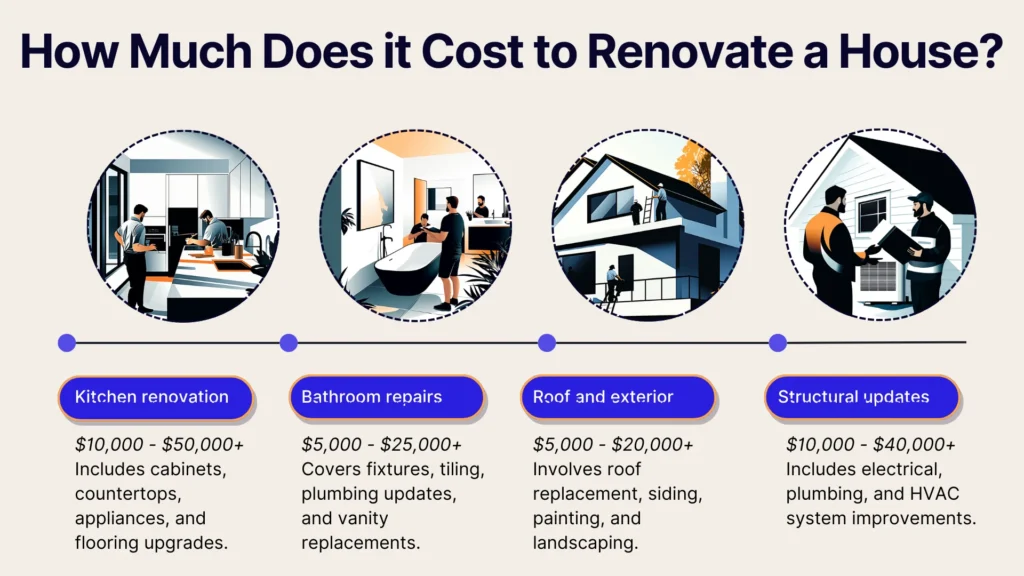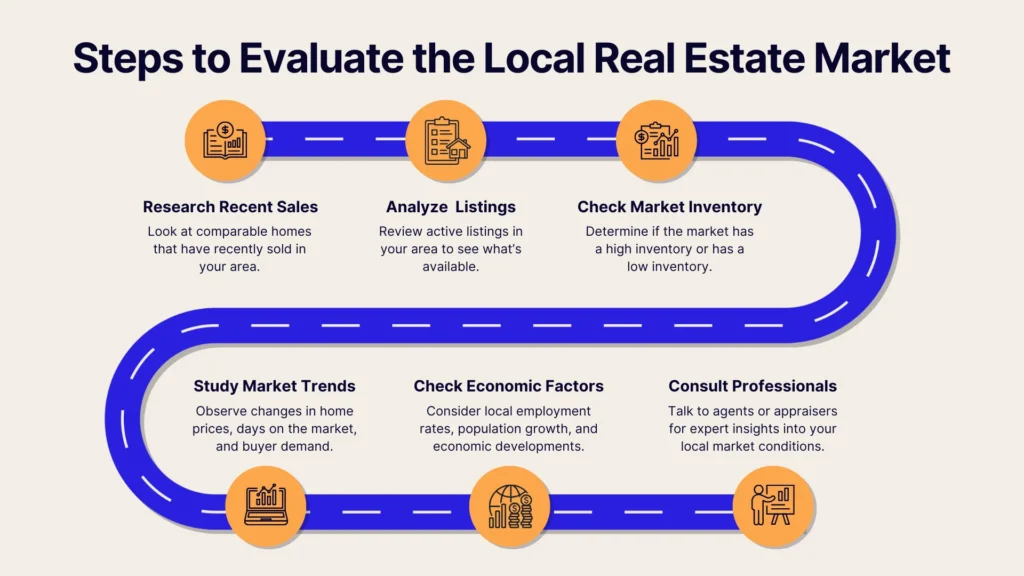Choosing between renovating your home or selling it as-is can feel overwhelming. Each option has its benefits and challenges, and the best choice depends on your situation, financial goals, and the real estate market. A significant number of homeowners consider renovations to boost their home's value and appeal before selling.
While renovating can breathe new life into your home and increase its value, selling as-is can provide a fresh start and potentially save you the hassle of managing extensive renovations. This article will guide you through the pros and cons of each, offering insights to help you determine which option aligns with your goals, budget, and lifestyle.
Why Consider Renovating Before Selling?
Renovating before selling can increase your home’s value and make it more attractive to buyers. However, it’s essential to determine whether the investment is worth the potential return. Here’s why you may want to renovate prior to listing your home for sale:

Increase Property Value
Upgrading your home can significantly raise its market value, particularly if you focus on high-impact areas like the kitchen, bathrooms, and exterior. Buyers often gravitate toward homes with modern finishes and functional upgrades.
For instance, updating a dated kitchen with sleek appliances, quartz countertops, and soft-close cabinets often delivers a strong return on investment (ROI). According to the National Association of Realtors (NAR), a minor kitchen remodel recoups about 81% of its cost. Similarly, energy-efficient improvements or a bathroom upgrade can attract eco-conscious buyers willing to pay more.
Exterior enhancements, such as new siding or energy-efficient windows, not only add curb appeal but also reduce maintenance concerns for future owners. Buyers appreciate homes that look fresh and well-maintained.
Cosmetic Updates Vs. Major Remodels
Not all renovations provide the same return. Simple updates like fresh paint, modern light fixtures, or refinished floors are affordable and have a noticeable impact. These cosmetic changes often offer a solid ROI with minimal risk.
On the other hand, major remodels like adding a new room or replacing an entire roof involve higher costs and greater complexity. While they may increase value, they also carry a higher risk of not recouping the investment.
Improve Marketability
Renovations can make your home more appealing, especially in competitive markets. Buyers often prefer move-in-ready homes over those requiring repairs. For example, a freshly painted exterior and a well-manicured lawn can create a positive first impression that encourages offers.
In bustling urban markets, move-in-ready homes frequently sell faster than fixer-uppers. They often attract multiple offers within days of listing, giving sellers an advantage.
Staging And Curb Appeal Enhancements
Curb appeal and staging play crucial roles in attracting buyers. Homes with enhanced curb appeal sell for more on average compared to properties that ignore this factor. Improving curb appeal doesn’t have to be expensive. Adding colorful plants, upgrading the mailbox, or power-washing the driveway can make a big difference.
Inside the home, staging helps buyers imagine themselves living there. Neutral-toned furniture, minimal clutter, and subtle touches like fresh flowers or scented candles create a welcoming atmosphere. Highlighting functional spaces, such as a well-organized home office, can also resonate with today’s buyers.
Customizing For Current Living Or Showcasing
If you have time before selling, renovations can serve a dual purpose. You’ll enjoy the upgrades while living in the home and later showcase them to potential buyers. For instance, a remodeled kitchen with an open layout might enhance your daily life and become a selling point when you list the home.
Additionally, living in the space after renovating helps identify and resolve minor issues, ensuring the home is in top condition when it hits the market.
Key Considerations For Renovation
Before you commit to renovating, consider these critical factors to ensure your investment aligns with your goals:
Cost Vs. Return On Investment
Weigh the cost of renovations against the expected ROI. Some upgrades, like minor kitchen remodels or fresh paint, deliver high returns, while others, such as luxury additions, may not. To maximize ROI, focus on improvements that appeal to local buyers.
Consult real estate blogs and contractors for advice on popular upgrades in your area. For example, solar panels might attract buyers in eco-conscious communities, while outdoor living spaces could be a priority in suburban neighborhoods.

Estimating Potential Sale Price Increase
Research recent sales in your area to gauge how renovations might affect your home’s value. For instance, if updated kitchens are common in your neighborhood and homes with them sell for $50,000 more, investing $20,000 in a kitchen renovation could make sense.
Online valuation tools and professional appraisals can help estimate the potential increase in sale price. However, always account for market fluctuations and adjust expectations accordingly.
Personal Involvement Vs. Hiring Professionals
Decide whether to tackle renovations yourself or hire professionals. DIY projects save money but require time, skill, and effort. Hiring professionals ensures high-quality results but increases costs. Homeowners unfamiliar with renovation projects often benefit from working with reputable contractors who handle permits, timelines, and quality assurance.
Impact On The Selling Timeline
Renovations can delay your selling timeline. Smaller updates, like painting or landscaping, may take weeks, while significant remodels could extend the timeline by months. Ensure these delays fit within your broader plans. Discuss your timeline with contractors and agents to determine whether renovations align with your goals. Sometimes, a faster sale without renovations may be the better option.
Market Timing
Real estate markets fluctuate. In a seller’s market, where homes sell quickly, renovations might not be necessary to attract buyers. In a buyer’s market, strategic upgrades can make your home stand out. Consult a local real estate agent to assess the best time to list your home, considering market trends and seasonal factors.
Benefits Of Selling Without Renovating
Selling your home as-is offers its own set of advantages. Here’s why you might consider this option:

Quicker Sale Process
Listing your home as-is speeds up the selling process. If you need to move quickly or avoid the stress of renovations, this approach can save time. As-is homes typically spend less time on the market compared to renovated properties. This strategy works well in hot markets where buyers are eager to close quickly, often waiving inspection or repair contingencies.
Saving On Renovation Costs
Skipping renovations eliminates upfront expenses and the risk of overspending. This option is ideal if you lack funds or are unsure about recouping your investment. Additionally, selling as-is shifts renovation responsibilities to the buyer, allowing them to tailor the property to their preferences. This flexibility can attract a broader range of buyers.
Attracting Different Types Of Buyers
As-is homes often appeal to investors, flippers, and buyers seeking fixer-uppers. These groups look for properties with potential and are willing to take on renovations themselves. In neighborhoods undergoing revitalization, as-is homes can be particularly appealing. Investors often purchase these properties to remodel and resell for a profit, driving demand.
Evaluating The Local Real Estate Market
Your local market plays a significant role in deciding whether to renovate or sell as-is. Research your local market conditions thoroughly to understand which option will fit your goals better. Here are factors you should consider:

Current Trends In Home Values
Examine whether home values in your area are rising or falling. If prices are climbing, renovations might yield a higher return. If prices are stable or declining, selling as-is could be more practical.
Review local real estate reports to see how your neighborhood compares to broader market trends. AI-powered real estate platforms like Propbox can perform this research for you and provide insights into the current real estate market trends. This data helps inform whether to invest in upgrades or prioritize a quick sale.
Buyer Preferences In Your Area
Understand what buyers in your area value most. Urban buyers might prioritize energy-efficient appliances or smart home technology, while suburban buyers may focus on outdoor living spaces and functional home offices. Tailoring renovations to meet these preferences increases your home’s appeal. For instance, adding a deck or upgrading HVAC systems might resonate more with local buyers than cosmetic changes alone.
Similar Sold Properties
Analyze recently sold homes in your neighborhood to see how renovations impact sale prices. Homes with similar layouts and upgrades provide a benchmark for estimating your property’s potential value. For example, if homes with finished basements sell for $30,000 more than those without, adding this feature could offer a strong ROI. Local agents can provide detailed insights into these trends, ensuring your renovations align with market expectations.
Current Listings Competition
Evaluate other homes for sale in your area. If many updated homes are available, renovating can help your property stand out. Conversely, if move-in-ready options are scarce, selling as-is may suffice. Pay attention to how competing homes highlight specific features, such as energy efficiency or modern kitchens. Incorporating similar upgrades can position your home competitively, especially in a crowded market.
Conclusion
Deciding whether to renovate or sell your house as-is depends on your goals, resources, and the local market. Renovating can boost value and attract more buyers, but it requires time and investment. Selling as-is offers speed and simplicity but may result in a lower sale price.
Assess your financial objectives, the state of the market, and your timeline. If maximizing profit is your goal, focus on cost-effective renovations with high ROI. If you prioritize convenience, selling as-is might be the better choice.
Renovate or sell as-is? Either way, Propbox makes selling your home faster and easier. With AI-driven pricing tools, automated scheduling, and data-driven insights, you’ll stay organized while protecting your interests better than a traditional realtor.
